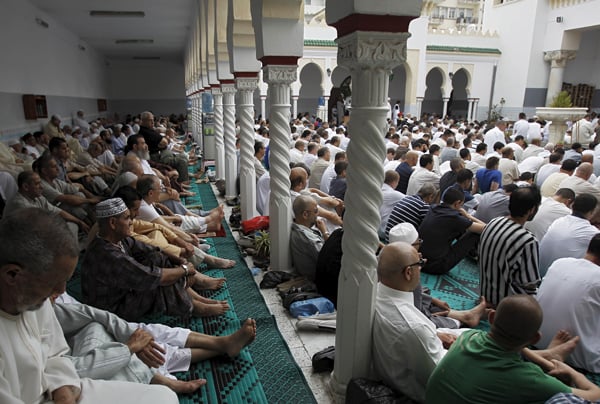
The Djamaa El Djazair mosque is being built facing the picturesque bay of Algiers as part of a complex that will include a one-million book library, a Quranic school and a museum of Islamic art and history.
Australian Football League slams anti-mosque banner at Melbourne game
It will also have a 265-metre high minaret (874 feet) -- the world's tallest -- as well as a 20,000 square metres prayer hall capable of accommodating up to 120,000 worshippers.
The complex will be located between a future tourist hotspot and working class districts that were once a bastion for extremists.
The North African country was battered by a civil war in the 1990s between the government and Islamists that killed some 200,000 people.
More than two decades later, armed groups remain active in parts of Algeria and the country has been hit by several devastating attacks claimed by al-Qaeda in recent years.
"Some have accused us of building a temple for the extremists," said Ahmed Madani, an adviser to the minister of housing responsible for the construction, which is being carried out by a Chinese firm.
"On the contrary, it will be a heavy blow for the extremists. They are the ones hostile to this project," said Madani.
The new mosque -- due to be completed in 2017 -- will be "an emblem of moderate Islam in Algeria and a shield against all forms of extremism," said Madani, who hopes it will draw Muslims away from extremist-run houses of worship.
According to Madani, Algerian officials have been mulling the idea of building a mega-mosque since 1962, the year Algeria gained its independence from France.
"The dream started becoming a reality" after the election of Bouteflika, a man known for his piety and devotion to Muslim art and culture, Madani said.
With few mosques around, Muslims in Italy take to praying at supermarkets, car parks
The 79-year-old president has been in power since 1999. He is respected by many for his role in ending the civil war but his opponents and rights groups accuse him of having an authoritarian streak.
The new mosque "will not only serve as a house of worship. It will be a place where links between faith and culture will be reinforced thanks to its ultra-modern library and the Koranic school which will be open to some 300 students," said Madani.
Oil-rich Algeria is already home to more than 30,000 mosques.
The construction of Djamaa El Djazair -- dubbed "Bouteflika Mosque" by some -- was launched in 2012, when oil prices were high, said Housing Minister Abdeladjid Tebboune.
Four years later, Algeria is facing revenue shortages due to weaker oil prices and its foreign exchange reserves have fallen.
The new mosque complex has a price tag of 1.2 billion euros ($1.4 billion), with online critics saying the cost is "mind-boggling" and that the money should have been used to build hospitals and improve health care.
Experts questioned by AFP have bemoaned what many have described as an "unsound" project, and warned that the cost of this mammoth construction could further grow if deadlines are not met.
"Most of the work is far from over and it will take a lot of time to finish everything," said an architect, referring to technical installations as well mural decorations including calligraphy that is still unfinished.
The mosque will be equipped with solar panels and a sophisticated system to retain rain water which will then be recycled for other uses.
Experts have also warned against the risks of the mosque being destroyed in an earthquake.
Algeria sits astride two major plates and is regularly hit by earthquakes, especially along the Mediterranean coast.
Italian officials spark outrage after removing prayer mats from city hall
A 2003 earthquake that hit the coastal town of Boumerdes to the east of Algiers killed nearly 3,000 people and injured 10,000.
Earthquake expert Abdelakrim Chelghoum has told authorities that a seismic study conducted by a German firm underestimated the risk of an earthquake damaging the mosque.
But Madani has dismissed the concern.
He said a mechanism capable of absorbing earth movements has been put into place and could decrease the effect of a magnitude 9 quake to that of a 3.5 tremor.


1732266251-0/Josh-Brolin-(1)1732266251-0-165x106.webp)
1732266343-0/BeFunky-collage-(82)1732266343-0-165x106.webp)

1732261957-1/Copy-of-Untitled-(66)1732261957-1-270x192.webp)


1732258132-0/BeFunk_§_]__-(26)1732258132-0.jpg)








COMMENTS
Comments are moderated and generally will be posted if they are on-topic and not abusive.
For more information, please see our Comments FAQ